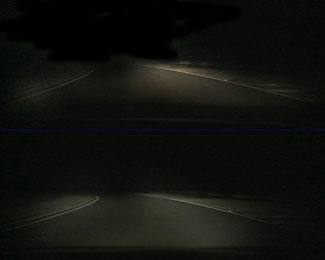Headlamp systems through the lens

Continuous innovation in headlamp systems also implies an improvement in how they are assessed. These assessment systems are based on dynamic comparison, i.e., experts or users themselves assess the quality of headlamps by means of different driving tests. The disadvantages of this type of assessment are the elevated cost and the fact that short-term visual retention does not guarantee definitive results. For this reason, the Department of Electrical, Lighting and Signal Development at SEAT's Technical Centre in Martorell, and Computer Vision Centre of UAB have created a recording system. The frames from these recordings will later be viewed and compared. However, first they will have to be spatially synchronised and aligned in order to adjust the results to real driving situations.
Continuous innovations in automotive lighting technology pose the problem of how to assess new headlights systems. For car manufacturers, assessment is mostly relative: given a headlights system to be tested, how does it compare to another one, maybe from a different supplier, in terms of features like light intensity, homogeneity or reach? This comparison is best performed dynamically, asking experts to actually drive along a certain testing track to later write down the visual impressions they remember.
However, this procedure suffers from several drawbacks: comparisons can not be repeated, are not retrospective and can not be either properly shared with other people since the only record is a paper form. To overcome them, we propose to record, for each headlights system, a video sequence of what the driver sees with a camera attached to the windshield screen. The problem becomes now how to compare a pair of such sequences. Two issues must be addressed: the temporal alignment or synchronization of the two sequences, and then the spatial alignment or registration of all the corresponding frames.
In this work we propose a semi-automatic but fast procedure for the former, and an automatic method for the later. In addition, we explore an alternative to the joint visualization of corresponding frames called the bird's view transform, and propose a simple fusion technique for a better visualization of the headlights differences in
two sequences. Results are provided for a number of headlights with different light sources and from several vehicle brands.
A series of still images can not convey the dynamic aspect of the results for this kind of application. Therefore, we have built a web page where a number of original and synchronized videos can be played. Please visit http://www.cvc.uab.es/adas/projects/sincro/JAE/ for the proper visualization of results.
References
Dynamic comparison of headlights. Serrat, J; Diego, F; Lumbreras, F; Alvarez, JM; Lopez, A; Elvira, C. PROCEEDINGS OF THE INSTITUTION OF MECHANICAL ENGINEERS PART D-JOURNAL OF AUTOMOBILE ENGINEERING, 222 (D5): 643-656 MAY 2008


